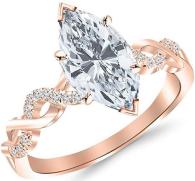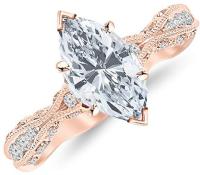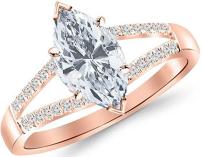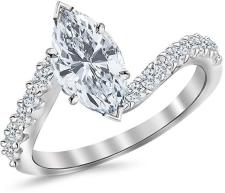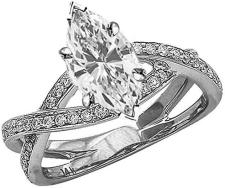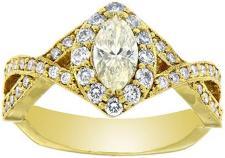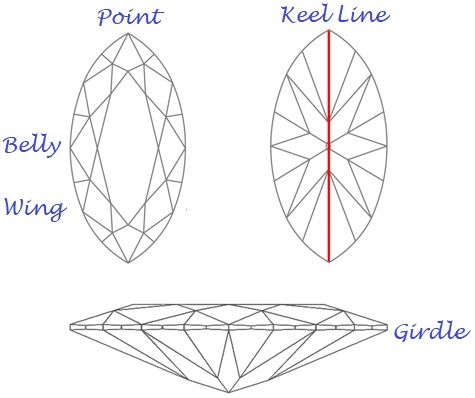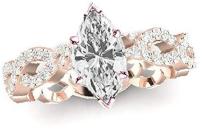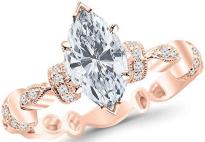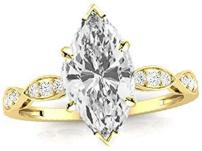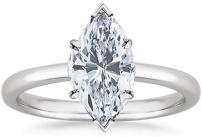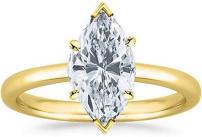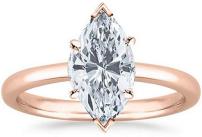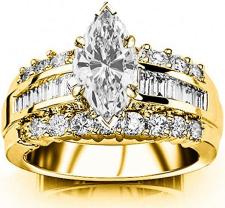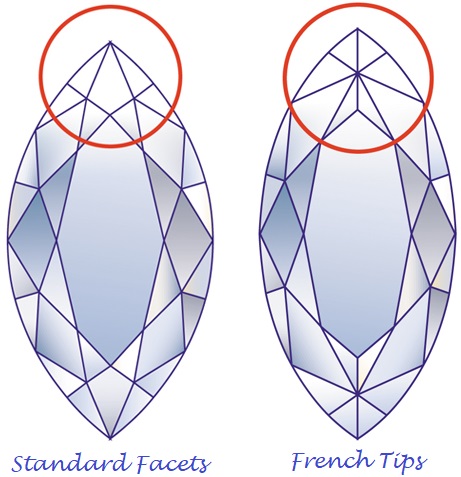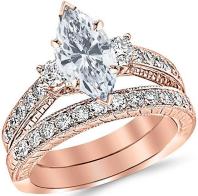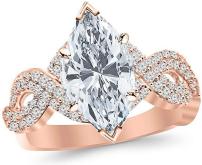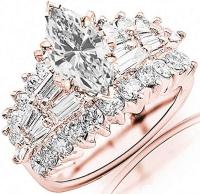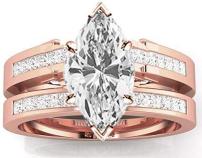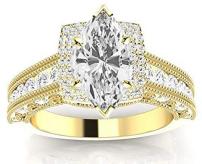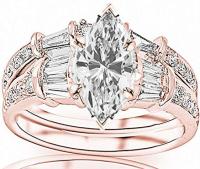Are you a hopeless romantic looking for a ring with regal air? How about the gorgeous marquise diamond. It descends from a royal lineage. And it looks resplendent on a ring.
Click On The Images
The origin of the cut can be traced back to the legend of the eighteenth-century when King Louis XV of France (1710-1774) commissioned a jeweler to design a cut shape resembling the lips of his mistress. See, how royal and romantic the origin of this cut are. Eventually, the marquise cut evolved into the distinctive shape by which it is recognized today.
The marquise diamond shape is also fondly called the ‘Navette’ shape which means ‘little boat’. It is because the shape of the diamond looks like the hull of a small boat. The football shape cut and the eye shape cut are other names attributed to this adorable shape.
Click On The Images
The cut features a graceful, elongated-elliptical shape consisting of 58 facets. Of these 25 are on the pavilion and 33 are on the crown. The facets are distributed in such a manner over the surface of the stone that the reflection of light radiates outwards from the center. Furthermore, Marquise shapes are occasionally cut with a “French tip,” which substitutes the large bezel facet at the point with star & upper girdle facets.
Originally designed for shaping diamonds, the cut has been wholeheartedly embraced for precious gems like sapphires, rubies and emeralds.
18k Yellow Gold Marquise Shaped Diamond Halo And Twisted Shank Engagement Ring Size 5.5
Click On The Image
The marquise shape has some inherent advantages. A marquise diamond looks significantly larger to the eye than a round diamond of the same carat weight. This is because of the large crown facets of this diamond. The diamond also makes the finger on which it rests look flatteringly long and slender.
Knowing The Parts Of a Marquise Diamond
Parts of a marquise diamond anatomy (belly, wing, point, girdle and keel line)
Diamonds of shape other than round are called ‘fancy shapes.’ The marquise shape belongs to the fancy shape category. Learn about the various parts of a Marquise diamond to be able to pick a good one for yourself.
Belly:
The central region where the sides bulge out the most is the belly. The width of the diamond is recorded by measuring it at this spot.
Click On The Images
Point:
These are the two points where both the curved sides come and meet at either ends of the diamond. The two points should align perfectly with one another as otherwise the symmetry of the diamond will be affected. And marquises are very sensitive to symmetry details. Poor cutting can ruin much of the wonders of a marquise.
Wing:
The curved area extending from the ‘belly’ to the ‘point’ is called the wing.
Girdle:
The junction of the pavilion (bottom facets) and the crown (top of the diamond) is known as the girdle. It defines the perimeter of the diamond. Search for stones with girdle-sizes ranging from thin to thick. Exceedingly thin girdles are prone to chipping. On the other hand very thick girdles give the diamond an ungainly lopsided look.
Click On The Images
Keel line:
In a round shaped diamond, the pavilion facets culminate at the tip of the pavilion at a single point. However, in fancy shapes including our Marquise, they form an edge called the ‘keel line.’ As such, the keel-line lies at the bottom-side of the marquise cut, where the pavilion facets come and meet. It moves along the length of the diamond. It might include or pass through the culet facet in the center.
Desirable traits in a Marquise Diamond
Basics that bestow beauty to a Marquise diamond are as follows:
Girdle Thickness:
The girdle provides the setting edge to this diamond. The diamond is set in your ring (or any other piece of jewelry) along the girdle. An adequately thick girdle curtails the risk of accidental damage.
3.1 Ctw 14K White Gold GIA Certified Marquise Cut Channel Set Baguette and Round Diamond Engagement Ring
Click On The Image
Girdle thickness is gauged by a minute examination of this thin band that is the junction of the top & bottom portions of your diamond. An inordinately thick girdle leads to a diamond that is heavier than what its face up appearance implies. It is called dead weight. And it means that a heavier diamond will look smaller. Obviously, this is not desirable. On the other hand, a thinner than necessary girdle makes the diamond prone to inadvertent damage like chipping.
Nevertheless, in case of fancy shapes such as the marquise, some concessions are conceded. Somewhat thicker girdles are allowed (particularly at the locations of the pointed edges) as a bulwark for the ‘points’ which are the most susceptible regions of a marquise diamond.
French Tips:
The marquise on the left has a standard facet arrangement on its tip, while the marquise on the right has French tips
For achieving the same purpose of protecting the points, marquise shapes are sometimes cut with a “French tip.” This is realized by replacing the large bezel facet at the ‘points’ with star & upper girdle facets.
The Length-to-Width Ratio:
The diamond’s length-to-width ratio is expressed as a proportionate comparison of its length (between the two points) to its transverse width (across the belly). For example, if the length is twice the width, it is called a length-to-width ration of 2:1. This attribute determines how thin and narrow or fat and bulging the diamond looks. Individual inclinations and preferences should prescribe the length-to-width ratio. And yet a length to width ratio of 1.75 -2.15 is considered the classic marquise cut.Click On The Images
Faceting a longer marquise diamond so as to maintain an eye-catching face-up appearance of brightness and pattern similar to a shorter diamond is a tough task. Then again, too short a marquise may look “squat.” A balance has to be struck. And as said earlier, personal preferences are the best judge for this attribute.Symmetry:
The visual appeal of a marquise diamond cascades from the symmetry of its shape.
The wings should be perfectly symmetrical. The cutter needs to have his geometry correct to curve the wings coequally.
The left and the right halves of the diamond should be even in outline and equal in length. Similarly, the facets on the left and right halves should display mirror symmetry. That is, they should be same size, the same shape and be at the same distance from the central axis of the diamond both horizontal and vertical. Symmetrical facets make covetable diamonds.
Shape Appeal:
In addition to symmetry, the shape appeal of a diamond is also an important factor to be considered. The diamond should appear poised and eye-pleasing. Some bloopers that mar the shape appeal may be flat-wings (wings with less than requisite curves), bulged-wings (wings with more than requisite curve), uneven-wings (wings with different curvatures) or undefined-points (points that are rounded instead of sharp).
A Marquise Diamond and Its Bow-Tie
In case of fancy cut diamonds including the marquise, another typical cut imperfection crops up. Known as the bow-tie, it appears as its name suggests. Dark shadow patches resembling a man’s bow tie show across the width of the diamond’s body.
Click On The Images
A bow-tie can be light gray to black. Wider and prominent ones take away from the beauty of a diamond. Regardless, a certain degree of this phenomenon is inevitable if the diamond has to acquire brightness and life. Moreover, a slight degree of bow-tie adds to the visual appeal of the diamond. But it should not be blatantly conspicuous.
The bow-tie effect is caused by obstruction of light in the process of viewing the stone. When you look at the diamond, some rays of incident light are blocked by your head and shoulders. The resulting shadow is reflected inside the stone, thus creating the bow-tie.
The bow-tie effect becomes pronounced when a diamond has either shallow or very deep pavilions. An expert cutter reduces this effect by carving slightly deep pavilions and playing around with faceting variations.
To gauge the degree of bow-tie effect in a marquise diamond, look at it in the face-up position without magnification. View it at such a distance as if you were wearing in on your hand and under normal lighting conditions. In this position, your head and shoulders will block some incident light rays. The resulting shadow casts a bow-tie of darkness.
Or See More Diamond Shapes As Follows:
| Round Brilliant Diamond | Princess Cut Diamonds |
| Baguette Diamonds | Asscher Cut Diamond |
| Emerald Cut Diamond | Gemstone Cleaning Guide |
